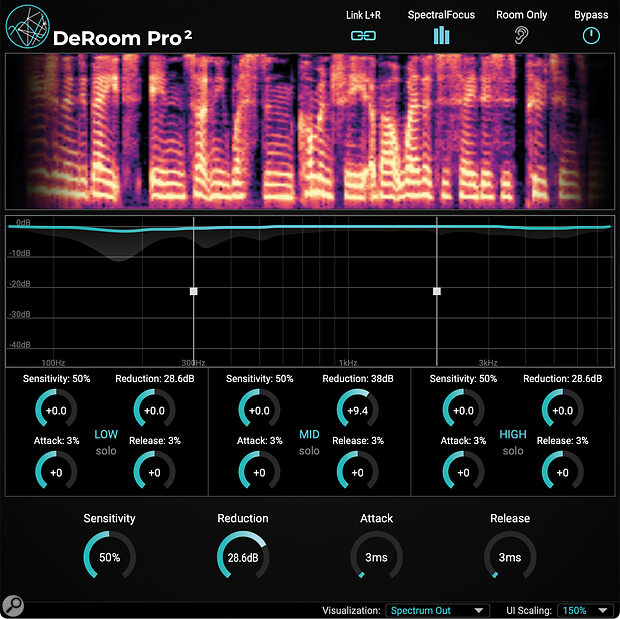Removing ‘baked in’ room sound is no longer the stuff of dreams, and this clever plug‑in does it better than most.
I’ve been doing a lot of podcast production recently, dealing with recordings of a few people captured remotely using Zencastr. While I’ve been able to offer a little advice on the participants’ recording setups, much remains beyond my control and the recordings inevitably suffer from a number of problems, not least of which is the undesirable sound of the domestic rooms and offices used for the recordings. There are various options open to us now to reduce ‘room sound’ in post‑production. For example, I’ve used iZotope RX (version 10 of which is reviewed in this issue) and Accusonus ERA 6 (still working, but sadly no longer available to buy) to reasonably good effect, and Descript’s Studio Sound feature can be an impressive ‘quick fix’ too. But, dissatisfied with the side‑effects, particularly when more assertive room removal is required, I decided that I should audition some other options — and my pick of the pack so far is Accentize DeRoom Pro.
Authorised via iLok, DeRoom Pro is a real‑time plug‑in underpinned by machine‑learning techniques, and it can be authorised to a dongle or to up to two separate machines. Mac and Windows are supported, an AAX, VST3 or AU host is required, and it can process mono or stereo sources at 44.1, 48, 88.2, 96 or 192 kHz sample rates.
Overview
The default GUI is pleasingly clean and uncluttered, with a representation of the reverb removal, along with a handful of main controls: you can set the sensitivity of the detection, the amount of reverb reduction (a dynamic process whose activity is reflected in real time on the curve above), and fine‑tune the result with attack and release controls, to make the process a touch smoother at the cost of letting a shade more reverb through. At the top, you can choose to link the L and R channel processing (or not), hit a Room Only button to audition what’s being removed, bypass the plug‑in, or enter SpectralFocus mode, of which more below.
 The default single‑band view, showing the waveform rather than spectral view. (The multiband SpectralFocus mode, with before and after spectral view, is shown in the main picture.)
The default single‑band view, showing the waveform rather than spectral view. (The multiband SpectralFocus mode, with before and after spectral view, is shown in the main picture.)
For the analyser, you have a range of options. You can display a waveform or spectral view, choose to hide the visualiser (reducing the temptation to judge settings by eye rather than ear), and display just the output signal, or both the input and output signals in adjacent ‘lanes’. Nearby is an option to scale the GUI: 80, 100 or 150 %, the last almost filling the height of my MacBook Pro Retina’s screen when in SpectralFocus mode. Speaking of which...
In SpectralFocus mode you’re given three bands to play with and have plenty of freedom in setting the crossover points: the first can be anywhere from 100Hz to 2kHz, while the second can be set from 300Hz to 6kHz. So you have the ability to really zone in on particularly problematic aspects of a room that might require more aggressive treatment. Each band is treated to its own Sensitivity, Reduction, Attack and Release knobs, and the equivalent global controls from the default view are retained.
It’s smoother‑sounding than any other real‑time reverb removal system I’ve tried to date.
It’s all very easy to use and to see what’s going on. Really intuitive. More importantly, the results are superb — it’s smoother sounding than any other real‑time reverb removal system I’ve tried, and while there will always be some side‑effects when you ask too much this sort of tool, those encountered here are mercifully minimal and their onset subtle. I’ve found I that can push the processing much further than the equivalent RX or ERA processes before encountering distracting ‘warbles’. I’ve also found that I can sometimes use two instances in series to good effect where more assertive processing is needed. And while they might not know precisely what’s changed, clients have certainly noticed the improved results!
DeRoom Pro is intended to treat dialogue and, it being based on machine learning, I wasn’t surprised to discover that it wasn’t hugely effective on other sources, such as guitars, drums or piano (in theory, the same tech could be ‘trained’ to recognise them, but it hasn’t been — yet). Still, I like to experiment, and found a cool alternative use for it in Listen mode to fake a drum ‘crush’ mic!
I thoroughly recommend DeRoom Pro, then, but as there’s a free fully functional trial, you needn’t take my word for it.
Summary
Stunningly good use of machine learning to suppress unwanted ‘room tone’ in real time.

